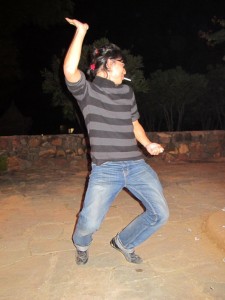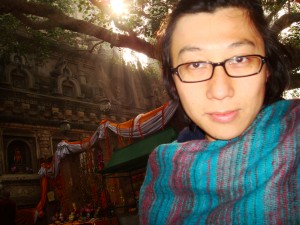Greetings from New York!
As you can tell, I’m trying out a new format for my sporadic, Kyoung Updates. As it turns out, my mailing list has grown to a point where I need an e-mailing service to catch up with you all. Hopefully, this will be a better way for me to communicate with you in the future, and if you’d like to continue getting my newsletters, please make sure to subscribe! This newsletter contains a link to my pictures from India, where I was a UNESCO-Aschberg Writer-in-Residence at Sanskriti Pratishthan, a link to my new website (www.kyounghpark.com), and a link to my upcoming production, the World Premiere of “disOriented” at the Peter Jay Sharp Theater on 42nd Street.
I returned to New York over two weeks ago, but with rehearsals and classes at Columbia starting last week, it’s just been a bit too hectic to get this newsletter organized.

My trip to India was enriching. This is my second time in New Delhi and I felt fortunate to return and be part of Sanskriti’s amazing community of artists. During my first trip to Delhi, I constantly heard wonders about the organization and now, having been there, I can see why. Sanskriti is an arts organization located southeast of New Delhi and it was built after the MacDowell Colony in the United States. Its founder, Mr. O.P. Jain, is a generous, forward-thinking, Indian philanthropist who is incredibly passionate about the arts. However, in one of our conversations, he said that out of all the arts, theater was the one he was least interested in, so that statement lingered with me during my time in Delhi.
During my trip, I was struck by the growing concerns from Indian artists in trying to preserve traditional, especially Hindu, arts. In a rapid, changing, society such as India’s, there are several local crafts that are becoming outdated, or outdone, with the advent of modern art and technologies. On a trip to a local crafts fair, my friend Mayank and I spotted some intricate, stunning, sketches printed on beautiful paper, and Mayank explained to me that these drawings were typically etched into the walls of people’s homes, when their houses were made with mud. During festivities, local artists would go into people’s homes, clear the mud walls with water, and sketch new images of folkloric Indian stories; but, since homes are now being built with cement, these artists have been left at bay.

This issue became clearer to me when I attended last year’s New Delhi Ibsen Festival, which produced several adaptations of Ibsen’s plays incorporating traditional, Indian arts. One of the plays I saw highlighted the use of phad paintings, which is basically a long piece of cloth with images depicting stories of well-known Rhajasthani deities. In the phads, the images are not necessarily displayed in chronological order, I was told that the Indian sense of time is non-linear (the past, present, and future all happen non-sequentially) so Bhopas (priest-singers) would light up the phad images in their appropriate order and tell the stories to people.
It was interesting to watch Ibsen, who is best known for his well-made plays, fused with a logic that is less concerned with causality. While reason and cause-and-effect is what drives Ibsen, and in a larger context, science and modernity, Indian performers spoke about being less concerned with causality, and more invested in performances that reached spiritual transcendence. Moreoever, at a conference which gathered the primary artists of the Ibsen Festival in Sanskriti, an Indian scholar told us about how he’s been traveling to villages, researching religious performances in temples. He said that due to a lack of research, these rites and performances were being handed down with less and less explanation as to why they are performed, so the traditions are being re-created locally without a deeper understanding as to what they mean. From this conversation I concluded that perhaps, this keen interest in preserving traditional arts, is related to a deeper need to preserve and understand traditional Indian–particulary Hindu–expressions amidst India’s quickly, developing society.
India as a country is overwhelming. There are so many layers upon layers of history, religions, and cultures laying one right on top of each other, that I feel I’ve only scratched the surface. However, this time around, its overwhelmingness didn’t run over me as it did on my first time, and I was able to find ways to find what I was looking for and keep focused. After all, with logic and causality out the window, my time in India increasingly resembled a spiritual quest, in which people and events sprung up in my life providing me clues in my search for what I was looking for…

The UNESCO was very generous in supporting my trip to work on my new dance-theater piece, THE DIAMOND TRADE, which I’ve been developing in New York. I took with me research, storyboards, and started investigating Hindu gods, the history of the Koh-I-Noor (a historic Indian diamond), and looking for ways to develop a second draft of the play. The research led me to learn about the Hindu goddess Kali; finding some really exciting–and kitschy–B-like religious movies; and I had deep conversations about the work I’ve done with dancers and choreographers. I was really lucky to have met such people through Sanskriti, and by sharing with them my work, I was able to not only define for myself what it is I’m interested in, in terms of dance, but how to merge my interests in both spirituality and dance without losing my voice in the process. To keep it short, I’ve realized modern, urban art is what interests me, especially in visual arts, music, and playwriting, so I feel that contemporary dance is what I should continue exploring–though my desire to respect traditional arts and local identities still resonates with me as an artist and is fundamentally, a big concern.
My exploration of physical performance was also reinforced by some other exciting plays I saw in Delhi, including “When we Dead Awaken,” directed by Saulius Antanas Varnas and “Mabou Mines’ Dollhouse”. I was so happy to participate in an actor’s workshop with Lee Breuer at Sanskriti; his integration of physical performances (Chinese masks, Meyerhold, and Viewpoints) and naturalistic performance (Stanislavsky and the American Method) was fascinating. It’s great to see when two juxtaposing aesthetics in the field don’t have to necessarily compete with each other, and his crafting and melding of both techniques was exactly the kind of aesthetic synthesis I was looking for as a model.
Meanwhile, digging deeper into what I was doing in India–after all, it’s pretty random to be there–I realized that there were certain unresolved issues from my previous trip to Delhi. My first time in India, I went there on this weird, spirtual trip and found myself in the Himalayas, converting to Buddhism with His Holiness, the Dalai Lama. Since then, I’ve been working on a play called HEARTBREAK/INDIA which, for the life of me, I’ve failed to write. After four, maybe five, unsuccesful drafts of the play, I realized I needed to question deeper my spiritual commitments to Buddhism and made of HEARTBREAK/INDIA and THE DIAMOND TRADE, sister-plays. They are sister-plays in my mind, because they are both based on my Indian influences, and originated from my need to explore the ideas I first found there. The only difference in these plays are the way perspectives influece form and content, as HEARTBREAK/INDIA is primarily a masculine play, while THE DIAMOND TRADE is feminine.

I left theatrical musings and research aside, and decided to go on a pilgrimage to the Bodhi tree where the Buddha became Enlightened. A lot of this journey is best described in the pictures I’ve attached, so all I’m going to say about that is that I’m still a Buddhist, and when time allows, I will find a teacher in New York to start learning the sutras. At the same time, after a series of weird accidents in my trip, I found a way to resolve what I was going to do with HEARTBREAK/INDIA and I’m well on my way to write, yet again, a new draft of the play which will finally go up on its feet this April at Columbia in a workshop production directed by Snehal Desai.
For now, though, I’m completely excited to announce the World Premiere of “disOriented.” The production is directed by the amazing Carlos Armesto and it’s being produced by his theater company, Theater C. We have received support from the Princess Grace Foundation to make this happen and I’m completely excited about this play. It’s been 4 years in the making and we’ll be running the show for three weeks, from Feb. 16th-Mar. 5th at the Peter Jay Sharp Theater on 42nd Street. This is a very, very big step for me as an artist and I hope you’ll come check-out my work. There will be more about the play in my next Kyoung Update, and in the meanwhile, here’s a brief link with more information about the play. I hope you can make it, and if you do, bring friends!
Peace,
Kyoung